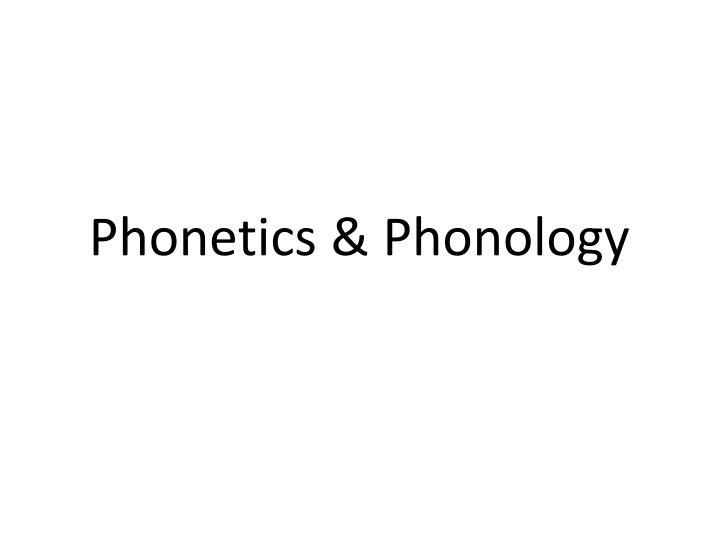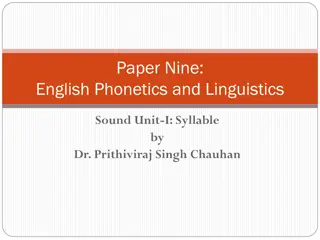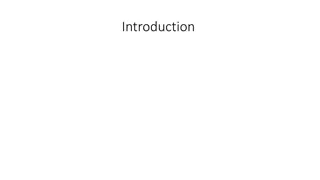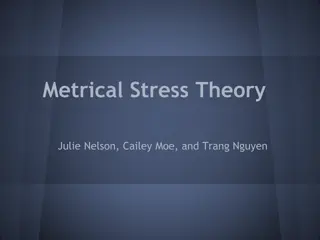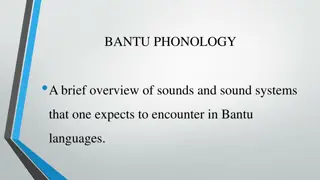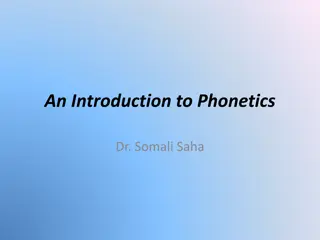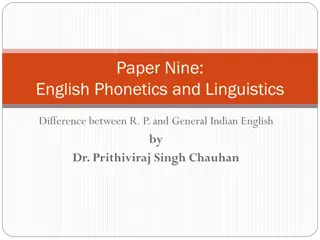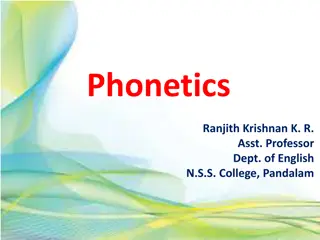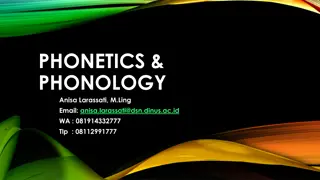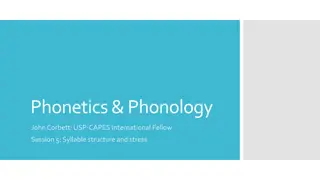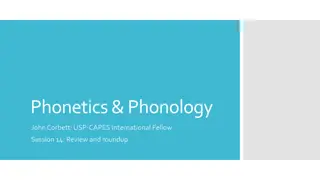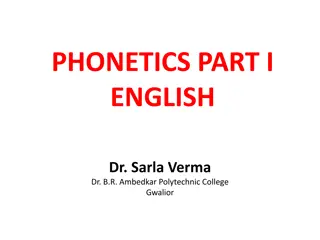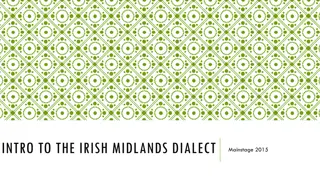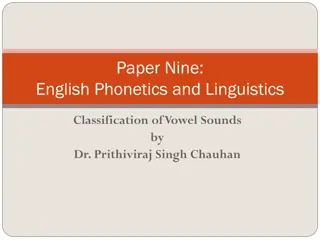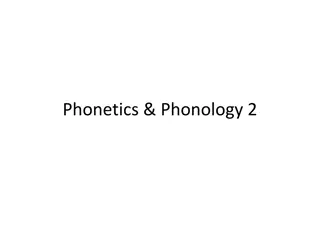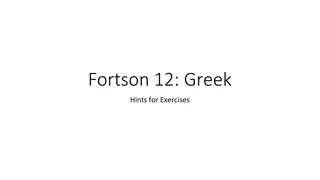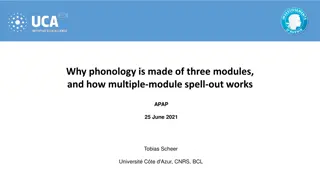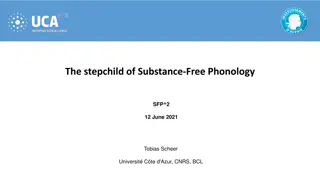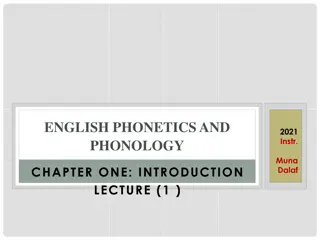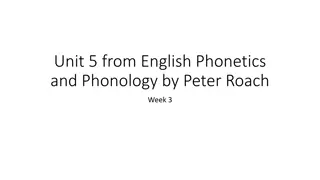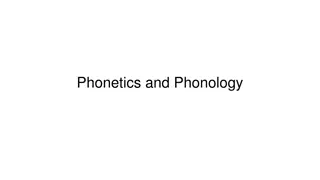Exploring the World of Phonetics and Phonology
Delve into the fascinating realms of phonetics and phonology, where the science of human speech sounds is decoded. From the production to perception of sounds, this field encompasses articulatory phonetics, auditory phonetics, and acoustics phonetics. Discover how speech sounds are intricately formed and perceived, and unravel the complexities of the International Phonetic Alphabet (IPA). Explore the intriguing nuances of speech sounds shaped by the human respiratory system, from pulmonic egressive to velaric ingressive and glottalic ingressive phenomena.
Download Presentation

Please find below an Image/Link to download the presentation.
The content on the website is provided AS IS for your information and personal use only. It may not be sold, licensed, or shared on other websites without obtaining consent from the author.If you encounter any issues during the download, it is possible that the publisher has removed the file from their server.
You are allowed to download the files provided on this website for personal or commercial use, subject to the condition that they are used lawfully. All files are the property of their respective owners.
The content on the website is provided AS IS for your information and personal use only. It may not be sold, licensed, or shared on other websites without obtaining consent from the author.
E N D
Presentation Transcript
the science of human speech sounds Phonetics studies how sounds are produced, transmitted and perceived.
Articulatory phonetics: Observes the organs involved in speech production X-ray photography and cinematography
Auditory phonetics: studies humans perception of sounds; how pronunciation is perceived by listeners. magnetic resonance imaging (MRI), and computerized tomography (CT)
Acoustics phonetics: studies the physical properties of sounds Spectrogram, Praat
One sound can be written using different letters: see, thief, receive, amoeba, and machine. The same letter can stand for different sounds: sign, pleasure, and resign; charter, character; father, all, about, apple, any, and age. A single sound can be written in different combination of sounds: lock, that, book, boast, mountain, shop, apple, or special. A single letter can represent a combination of sounds: exit, use A letter can stand for NO sound at all: know, doubt, though, island, rhubarb, or moose.
International Phonetic Alphabet (IPA). The IPA is a standardized representation of the natural languages sounds.
Speech sounds are created by modifying the volume and direction of a flow of air using various parts of the human respiratory system If the direction of the air is outwards (going out from the lungs to the mouth), then it is called pulmonic egressive (found in all human languages). If the direction of the air is inwards beginning from the velum or the glottis, then it is called velaric ingressive (found in Zulu in South Africa) and glottalic ingressive (found in Navajo in North America)
Oral cavity Upper lip Lower lip Upper teeth Alveolar ridge Tongue tip Tongue blade Tongue body Tongue root Epiglottis Pharynx Hard palate Soft palate (velum) Larynx [has the vocal folds] Vocal Tract (Articulatory Organs)
Speech sounds Segments Suprasegmentals 1. consonants (with constriction) 2. vowels (no constriction) consonants and vowels play roles in a syllable
Segmental Features: 1.Voicing: is the sound voiced or voiceless? 2.Place of articulation: where is the airstream constricted? 3.Manner of articulation: how is the airstream constricted?
Vocal folds vibrate = voiced Vocal folds do not vibrate = voiceless
Place of Articulation Description Phones Examples Bilabial Bringing lips together [p], [b], [m], [w] pat, mat, ball, window Labiodental Lower lip against the upper front teeth [f], [v] fat, vat, feel, veil, van [ ], [ ] Interdental Tip of the tongue protrude between front teeth the, thin, thigh Alveolar Tip of the tongue is at or near the alveolar ridge [t], [d], [s], [z], [n], [l], [ ] tree, door, sun, zoo, north, law, red Post-alveolar Made at the front of the hard palate, behind the alveolar ridge measure, leash, church, judge [ ], [ ], [t ], [d ] Palatal Tongue near the center of the hard palate [ ] yes Velar Tongue near the velum [k], [g], [ ] keep, girl, sing Glottal Made at glottis [h], [ ]<(glottal stop) hat, uh-oh
Manner of Articulation Description phones Examples Stops obstructing the airstream completely [p], [b], [t], [d], [k], [g], [ ] pool, bat, tree, deer, kite, girl, uh-oh Fricatives A nearly complete obstruction of the vocal tract. The opening for the air to pass is small leading to a friction father, van, sun, zebra, hall, jeans, ship, three, the [f], [v], [s], [z], [h], [ ], [ ], [ ], [ ] Affricates Stopping airstream, then releasing the articulators to produce a friction sound church, judge [ t ] , [ d ] Nasals Produced by lowering the velum to let the nasal passage open for the vocal tract north, king [ n ] , [ ] Liquids a narrow constriction that does not block the vocal tract. The airstream passes through the sides later, red [ l ] , [ ] Glides Slight closure to articulators [ w ] , [ j ] window, yawn Flap complete obstruction of the oral cavity with a fast closure; similar to stops. (found in AmE) ladder, water [ ]
The shape of the vocal tract and quality of a vowel can be changed through four main ways: 1.Raising or lowering the tongue 2.Advancing or retracting the tongue 3.Rounding or not rounding the lips 4.Making the above movements with tense or lax gesture Vowels are of two main types: 1. Monophthongs: a one-part vowel 2. Diphthongs: a two-part vowel
Suprasegmental features are those features that ride on segments. And they are: Length: met vs. meet Intonation: the pattern of pitch movements across a stretch of speech. Pitch is the rate of vibration of the vocal folds.
Tone: the use of pitch to make differences in a words meaning. Segment Tone pattern Meaning m high level mum/mom m high rising hemp low falling raising horse ma m high falling scold Stress: a property of the syllable. It makes a syllable more prominent than others. ex: record
